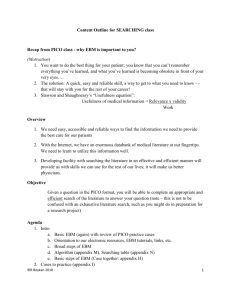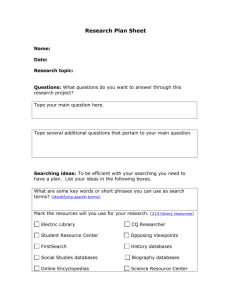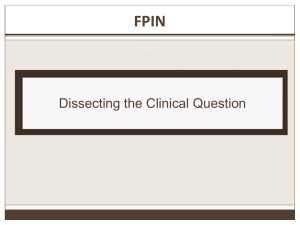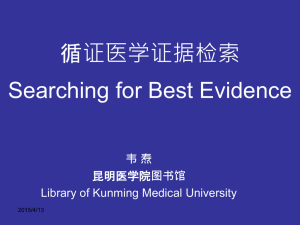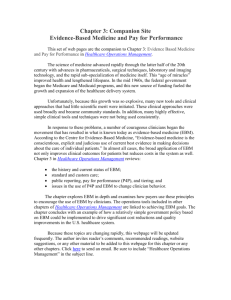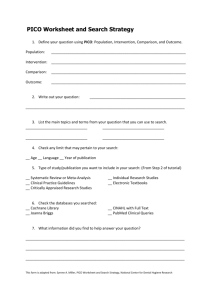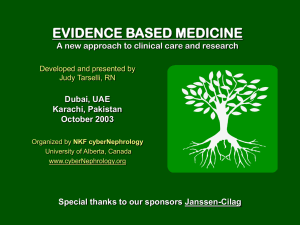Evidence Based Medicine
advertisement
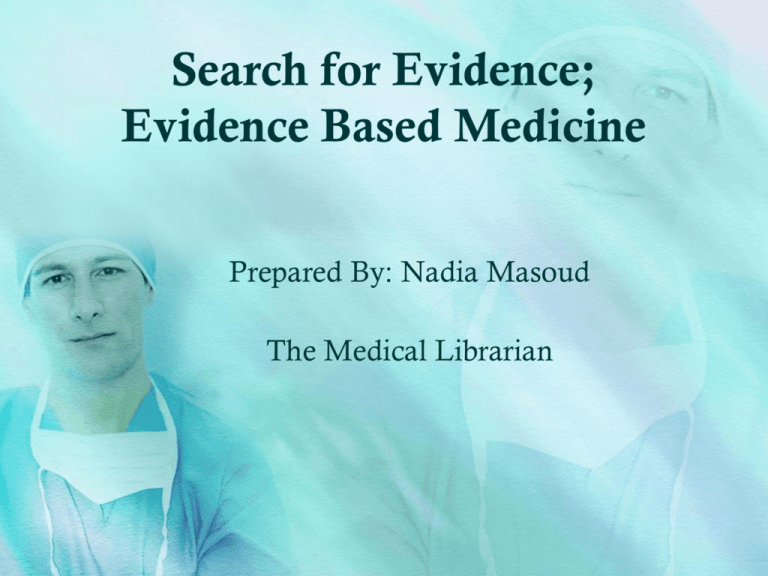
Search for Evidence; Evidence Based Medicine Prepared By: Nadia Masoud The Medical Librarian Physicians “NEED” EBM, WHY? In order to take a proper clinical decisions, physicians should keep up-todate with the Medical Literature. To keep themselves updated, physicians need to read at least 6-8 hours daily. These hours will be added to the busy schedule and work load they have daily. Physicians “NEED” EBM, WHY? • Need for valid information daily on Diagnosis, treatment, prognosis and prevention • Inadequate traditional sources: Outdated, too voluminous to be practical” (Textbooks) Frequently wrong (Expert opinions) Ineffective (Didactics/CME) Too overwhelming in volume and variable in validity (Medical Journals) EBM Founding Father Prof. Archibald Cochrane a British medical epidemiologist is the Founding Father of the Evidence Based Medicine Concept. “The Cochrane Collaboration”, the main source for EBM, was named after him. Evidence Based Medicine (EBM) Evidence-based medicine is the integration of best research evidence with clinical expertise and patient values Sackett DL, Straus SE, Richardson WS, Rosenberg W, and Haynes RB. EvidenceBased Medicine: How to Practice and Teach EBM, 2nd Ed, Churchill Livingstone, London, 2000 Evidence Based Medicine • Basis of Evidence-based care involves the integration of the best research evidence with clinical expertise and patient values. Best Clinical Evidence Clinical Experience Patient’s Needs/ Preferences The Evidence Based Cycle • • • • • • Identify and define the problem Formulate a focused clinical question Identify the appropriate resources Search for valid and relevant information Critical appraisal Implement in practice Types of Clinical Questions • Background Questions ask for general knowledge about a disease, disease process or clinical circumstances. • Background Questions are those questions which have been answered in the past and are now part of the “fiber of medicine” • Ask They generally ask "who, what, when, why, where or how" about a single disease, drug, intervention or concept. • You can find a helpful background information particular subject by searching Encyclopedias, dictionaries, textbooks, thesauri, ..etc. Bibliographies at the end of articles lead you to other books and articles on your topic, which might be very helpful. Types of Clinical Questions • Foreground Questions The foreground questions are the base of the EBM Search. They are more difficult to answer than background questions because they require sources that provide a wide range of knowledge and look for specific patient cases or problems. Searching the Online Databases • Choose the appropriate database • Consult at least two databases to prevent missing a significant piece of work on the subject • When using a new database, familiarize yourself with its language by using the online help Develop a Search Strategy There are seven steps to be considered for applying the EBM principles and responding to the clinical inquiries. • Receive and analyze the clinical question by using the PICO method • Expand your background, gather pertinent background information • Classify the clinical question into a category (therapy, diagnosis, etiology, prognosis) • Search for the information in the best resources • Evaluate literature for accuracy and relevance • Formulate a response • Communicate information and follow up(1) The EBM Process • • • • • Assess your patient Ask clinical questions Acquire the best evidence Appraise the evidence Apply the evidence to patient care ASK A Clinical Question • Formulate a well-built clinical questions. • In practice, well-built clinical questions usually contain four elements abbreviated in PICO Format • P - Patient / problem : Identify the problem of the patient • I - Intervention of Interest (such as a drug or test) • C – Comparison / the Comparison Intervention • O – Outcome / the Intended Outcome • Patient / Population – who and what? • Intervention – how? • Comparison (if appropriate) – what is the main alternative? • Outcome – what are you hoping to accomplish, measure, improve, affect? • • • • P = Patient/Problem/Population: Ask “how would I describe a group of patients similar to mine?” Balance precision with brevity I = Intervention: Ask “which main intervention am I considering?” (cause, prognostic factor, treatment, etc..) C = Comparison/Control: Ask “which is the main alternative to compare with the intervention?” again, be specific O = Outcome: Ask “what can I hope to accomplish?” or “what could this exposure really affect?” again, be specific. Types of Research Studies • 1-Randomized controlled trial: (answers therapy, prevention questions) Randomization avoids selection bias. Clinical trials that involve one test treatment and one control treatment, concurrent enrollment and follow up of the test-and control treated groups, and in which the treatments to be administered are selected by a random process. Types of Research Studies • 2-Cohort study: (answers prognosis, etiology, prevention questions) Cohorts are defined populations that, as a whole, are followed in an attempt to determine distinguishing subgroup characteristics. Researchers identify and compare two groups over a period of time. At the start of the study, one of the groups has a particular condition or receives a particular treatment, and the other does not. At the end of a certain amount of time, researchers compare the two groups to see how they did. Types of Research Studies • 3-Case control study: (answers prognosis, etiology, prevention questions) Case control studies are studies that identifies patients who already have the outcome of interest and control patients without that outcome, and look back to see if they had the exposure of interest or not. • 4-Case series and case reports: (answers prognosis, etiology, prevention questions) Consist either of collections of reports on the treatment of individual patients, or of reports on a single patient. Search for the Best Study Type of Question Best Type of Study to Search For Therapy RCT>cohort > case control > case series Diagnosis Prospective, blind comparison to a gold standard Etiology/Harm RCT > cohort > case control > case series Prognosis Cohort study > case control > case series Prevention Clinical Exam Cost RCT>cohort study > case control > case series Prospective, blind comparison to gold standard Economic analysis Acquire the Best Evidence • Online databases are the most important sources for evidence retrieval. • The best method to search for evidence is by using the “4S’ hierarchical structure of Evidence Databases, which consist • Systems; Online resources provide summary reviews of the relevant medical information on specific clinical cases. • Synopses; which are evidence based summaries prepared from original research • Synthesis; Systematic Reviews can be found through the Cochrane Library • Studies; Research published in non-filtered databases “4S’ Hierarchical Structure of the Online Databases to be Searched for EBM EBM Search Protocol Pyramid Navigating the Maze: Information Mastery: How to lower the work of Your Information Searches: An Overview, Health Sciences Library, University of Virginia Searching Tips, to Recall Relevant Evidence Search Strategy to build the Inquiry Strings should be implemented. They include; • Defining appropriate Keywords from the clinical question, Use Medical Subject Headings (MeSH) if required; • Considering Synonyms and related terms; • Selecting the most relevant databases; • Combining keywords with Boolean Operators; • Considering the “Phrase Searching” and Truncations. Boolean Searching Use Boolean Operators to combine search terms. These are the most common connectors: • “And” : To narrow your search. All terms must appear in results • “OR” : To broaden your search. Either term should appear in results • “Not” : To narrow your search by excluding specific terms. • “Adj” : Search for terms that appear together Using AND, OR, NOT, and ADJ to create logical search statements is also known as Boolean searching , Boolean Operators. Phrase Searching You can narrow your search by using a “Phrase Search” instead of keywords. Put your phrase between Quotations (“ “) Examples “Evidence Based Medicine” “Point of Care Testing” “Physical Therapy” Truncation To obtain more results and broaden your search, Truncate / Stem the word to its root. Truncation means shortening a search term by adding a symbol to the root of a word, to retrieve its variant endings Examples Search for “child*” retrieves documents for child, children, childhood, childbirth, …etc. The most used Truncation Symbol is the Asterisk (*) Tips for Smart Searching Always be as precise as possible when selecting keywords that describe your topic Check your spelling Use acronyms if available (WHO – World Health Organization ) Consider differences between American and British spelling (Hematology / Haematology – Pediatrics / Paediatrics) Clinical Case • Jeff, a smoker of more than 30 years, has talked about giving up smoking. He has tried unsuccessfully to quit in the past. He has heard through a friend that acupuncture was successful. Should he try it? Other interventions that you know of include nicotine replacement therapy and antidepressants. • Clinical question • In people who smoke is acupuncture compared to nicotine replacement therapy or antidepressants effective treatment for smoking cessation. PICO Population Smoker Intervention Acupuncture Comparison Nicotine replacement therapy OR antidepressants Outcome Smoking cessation Clinical Question Question Analysis / PICO Format Patient / Population : Intervention Comparison Outcome : : : Patients with chronic heart failure Chocolate intake No chocolate intake blood pressure Cochrane Library Search #1 : "heart failure" or "cardiovascular disease*“ Search #2 : "high blood pressure" or hypertension Search #3 : chocolate or cocoa Search #4 : 1 and 2 and 3 Clinical Question Is the land-based therapeutic exercise beneficial for people with knee OA in terms of reduced joint pain or improved physical function. ? Question Analysis / PICO Format Patient / Population : Intervention Comparison Outcome : Adults, Knee Osteoarthritis : Land-Based Therapeutic Exercise : Drug Therapy Reduce Pain / Improved Physical Function Search String knee$ and (osteoarthritis or OA) and (exercise or physiotherapy or "physical therapy") and ("reduc$ pain" or comfort$) Appraise the Evidence Critical Appraisal is the process of carefully and systematically examining research evidence to judge its trustworthiness, its value and relevance in a particular context. The purpose of the critical appraisal is to determine whether; • Research evidence is accurate and free of known or unknown bias, • Evidence results are acceptable and provide the answer to the question raised • How confidently can the evidence be applied to the practice Critical Appraisal Process Assess the Validity Are the results valid? A crucial question in the critical appraisal process. The recalled / retrieved evidence should be examined for; • Well Built PICO Question • Randomization for selecting participating patients to eliminate Bias • Research study should be blinded, or doubleblinded when possible. • Study groups must be treated equally • ensure that patients who started the trial are accounted for until the end. Critical Appraisal Process What are the Results? • What are the Results? Once the validity of the study is ensured, statistical analysis should be performed on the retrieved study results to check the Values . • Each study type, either Therapy or Diagnosis, etc. has its measures to calculate. • The findings / Calculation Results should fall within the range of True Values. Apply on the Patient • Decision should be taken whether to apply the evidence on the patient or not. • Physician should ask the following questions before Applying the evidence; • Is my patient so different from those in the study? • Is the treatment available in my setting OR Is the healthcare system willing to fund it • What are the alternatives available? • What are the side effects of the intervention? • Are the outcomes appropriate to my patient? Cochrane Group Lists New Example In post-menopausal women, does hormone replacement treatment therapy prevent osteoporosis Terms Osteoporosis / Bone Density / Bone Mass Post-menopaus$ / menopaus$ / women Hormone Replacement Therapy / HRT Search String Osteoporosis and menopaus$ and (“hormone treatment therapy” or hrt) Should you have any inquiries, please send an e-mail to nadia@sharjah.ac.ae OR Contact the Medical Library at 065057176 / 06-5057176 Thank You THANK YOU
